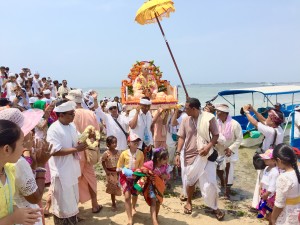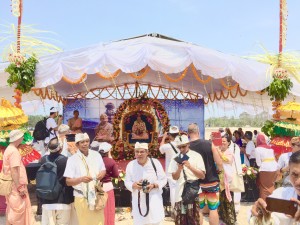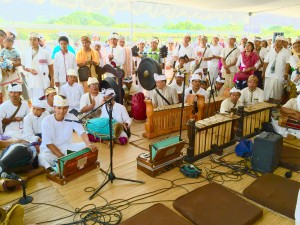The devotees in Bali celebrated Srila Prabhupada’s arrival into America by re-enacting his journey on the Jaladuta.
Sanur Beach Festival
Groundbreaking ceremony at Parsippany, New Jersey
→ The Vaishnava Voice
There’s a very old tradition of rituals in our Hare Krishna movement. Rather than being what people sometimes describe as ‘empty rituals,’ they are ceremonial offerings of service to the Divine, pleasing to the eye and ear, and satisfying to the heart. On a daily basis we keep them quite simple, but on special occasions we can create very elaborate and colourful festivals. The groundbreaking ceremony for the building of a new temple is one such occasion. A fire sacrifice is held, and a small statue of Ananta Sesha is buried deep down in the earth, directly beneath where the main altar will be.
This week, one such ceremony took place in Parsippany, New Jersey. It’s an important event because new temples come once in a lifetime for a community, particularly one built in a traditional style. Watch the short video here.
Hema Mukhi Leading Harinam
→ simple thoughts
Hema Mukhi Dasi
In this short video you will see and hear Hema Mukhi Dasi leading our Saturday Night Harinam in Leicester Square.
Hema Mukhi is very actively involved doing service for the UK Festival Team that goes all over the British Isles and sometimes into Europe, organising exciting Hare Krsna Festivals. The Festival programme was begun by Tribhuvanath Prabhu many moons ago and is still going strong under the direction of Giridhari Prabhu, Ratnavali Dasi and many others….
I really like it when Hema Mukhi leads Kirtan as she always chants loudly and clearly, using simple and sweet melodies.
She also chants in a humble and unaffected manner, avoiding the Krsnos and Ramos that have now infected our Societies Kirtan’s worldwide.
Come and join the Saturday Night Harinam Parties whenever you have the time.
Please remember your kartals and mrdangas 
Prasad Distribution Paris
→ simple thoughts
Prasad Distribution in Paris September 27th 2015
The French Revolution of 1798 is regarded by western historians as one of the most important events in human history. The revolution sparked off at the magnificent Place D’ La Republic, this is the location where another type of revolution was to happen, the Krishna Prasad “feeding of the 5,000”.
A revolution of consciousness, the Hare Krishna revolution. Referred to as the “spotless” Purana, the Bhagavatam is “directed towards bringing about a revolution in the impious lives of this world’s misdirected civilisation (SB 1.5.11)” 1.5.1
At this revolution almost 7,000 young people got a free plate of delicious subji, pakoras and a puri, and got to hear the Holy Name.
The Revolution of 1798 came about due to the popular resentment of the privileges enjoyed by the clergy and the aristocracy and similarly Lord Caitanya’s movement is open to one and all, even a dog can take part.
Lord Caitanya’s movement will always be street based, and centered on the free distribution of Bhakti.
A special thanks to the French devotees who came for the Harinams, including Mandakini prabhu, and the team of English householders with their children
Your servant Parasuram das
A Day in Preschool Class
→ TKG Academy
 Our preschool days are busy with various activities. Our mornings begin with Sadhana class. Sometimes we go on Harinama, chanting Lord Krsna’s Holy Names around the temple community, accompanied by musical instruments and feeling delighted; sometimes it’s a more solemn Japa walk. We also learned many stories and a song about Srila Prabhupada.
Our preschool days are busy with various activities. Our mornings begin with Sadhana class. Sometimes we go on Harinama, chanting Lord Krsna’s Holy Names around the temple community, accompanied by musical instruments and feeling delighted; sometimes it’s a more solemn Japa walk. We also learned many stories and a song about Srila Prabhupada.
During art class we made necklaces for Srimati Radharani and a drum to accompany our chanting of “Radhe Jaya Jaya Madhava Dayite”.
 In Language Arts we covered the first letter cluster. We made a snake and sun for ‘s’, a mouse and monkey for ‘m’, an alligator and apple for ‘a’ and a turtle and tiger for ‘t’.
In Language Arts we covered the first letter cluster. We made a snake and sun for ‘s’, a mouse and monkey for ‘m’, an alligator and apple for ‘a’ and a turtle and tiger for ‘t’.
For the math session we made a chart with the numbers 1-10, and decorated them with the matching number of sequence. We learned about the different types of coins and played pretend Bakery.
In science we learned about various land forms. We also made a book on the senses, describing their use and how they can be engaged in the loving service of the Lord Sri Krsna. We also learned about the three primary colors and how we can mix them to create other colors.

In Social Studies we focused on the differences between rural and urban communities and created a display of the typical characteristic of each.
Food For Life Nepal – update (Album with photos)
The situation…
→ Dandavats.com

Food For Life Nepal - update (Album with photos)
The situation is worst in Nepal at present: No petrol, No diesel and No LPG gas. Moreover, it is very difficult to find raw food items and even biscuits.
Although it is very difficult but Food For Life Nepal is daily feeding poor children.We use bike of our volunteers ( now vehicles are not available due to gas, petrol and diesel shortage.)
More than 630 poor children whom we provide the mid-day meal at their school are extremely thankful to our donors and contributors. Majority of them are no better than street children in this time of crisis.
Your small help can bring drastic change in their life. Please help Food For Life Nepal to feed those innocent poor children.
Find them here: https://goo.gl/JZmGbU
Hare Krishna! World Holy Name Week 2015 – Iskcon Indonesia
The…
→ Dandavats.com

Hare Krishna! World Holy Name Week 2015 – Iskcon Indonesia
The Indonesian devotees took up this year’s World Holy Name Week with great zest. Youth from all the temples/communities united to perform a Harinama Yajna never before held. On the first day, a 12 Hour Kirtan at the Sri Sri Radha Madhava Asrama (Gianyar, Bali) with His Holiness Kavicandra Swami (Co-GBC for Indonesia), His Holiness Ramai Swami (Co-GBC for Indonesia) and His Holiness Bhakti Raghava Swami in attendance. Devotees from the 5 temples and 3 centres took turns to complete the 12 Hours. After that, up until the first of October, 6 Hour Kirtans were held everyday at all of Bali’s temples and centres. On the weekends, it was maha harinam time, with the highlight being the Maha Harinama at Double-Six (Kuta) Beach at sunset on the 27th, with at least 40 devotees in attendance. On the 2nd of October, 1 Hour Japas and 5 Hour Kirtans were held at all the temples.
Read the entire article here: http://www.dandavats.com/?p=20246
Scientific Adventures
→ TKG Academy
Classroom studies come to life when you get to see things with your own eyes and feel them with your hands. At the conclusion of the first six weeks of school, after studying the body, 2nd through 9th graders took a trip to the Perot Museum of Nature and Science to further solidify their studies through exploration and experimentation. Of course, many experiments were performed within the classrooms as well, but the excitement of a field trip can hardly be replaced.
We focused most of our time at the “Being Human” hall, as well as the “Sports” hall. Some of the highlights were the “Bio Lab” where students examined cheek cells and germ killers. Other attractions were using light beams to reveal the blood vessels beneath our skin, and racing various species across the running track. We also watched a 3D movie about the Wonders of the Arctic.
Time was short and we left with taste for much more – hopefully to be satisfied at a later time with another science unit.
New Vrindaban Radhastami Celebration Filled With Love
→ New Vrindaban

By Madhava Smullen
Lord Krishna’s eternal consort Srimati Radharani is known as the Queen of Vrindavan. So what better place in the Western World to celebrate Her appearance day, Radhastami, than New Vrindaban?
Described by Srila Prabhupada as “non-different” from Vrindavan in India, New Vrindaban’s Radhastami festival on September 21st 2015 drew many devotees from neighboring states, as well thirty students with their professor from nearby Christian liberal arts school Bethany College.
Favored by devotees for its particularly sweet and loving mood, the festival began with the traditional temple morning program when Sri Sri Radha-Vrindabanchandra were revealed in a stunning new dark blue and silver bespoke outfit made in Vrindavan, India.
With Radha carrying an umbrella of marigolds from New Vrindaban’s gardens, Krishna leaning on a staff entwined with flowers, and both Their heads decorated with heart-shaped flower halos, Their Lordships were breathtaking to behold. And, of course, Srimati Radharani’s lotus feet were visible throughout the day, the only day in the year when She bestows this boon upon devotees.
Visiting for three days, Hridayananda Das Goswami brought his scholarly outlook to several classes explaining Radharani’s position as the feminine aspect of God, and Her qualities of compassion and devotion. He also shared memories of Srila Prabhupada’s 1972 visit to New Vrindaban during an evening program at Nityodita Das and Radha Dasi’s home.
At noon, devotees immersed themselves in the Vrindavan mood, gathering in the under-construction Radha Gopinath temple on New Vrindaban’s Govardhan Hill to sing kirtan before the small yet incredibly sweet presiding Deities.
As in the transcendental village She reigns over, many residents of New Vrindaban offered Srimati Radharani dishes they had made with love in their own homes, such as laddhus, baklava, and fruit salad. The preparations included a strawberry-almond cake baked by Lakshman Isvara Das in the shape of a lotus with twelve petals representing the twelve forests of Vraj.
While Radha enjoyed Her offerings, longtime resident Varsana Swami gave a class full of entrancing stories and revelations about Her pastimes with Krishna, including one wherein She beat the Lord in a wrestling match and pinned Him down until He conceded, “I surrender!”
As it was a beautiful day, all the devotees then sat outside on the grass of Govardhana Hill around the glittering waters of New Vrindaban’s Radha-Kunda, Shyama-Kunda and Lalita-Kund to honor a prasadam lunch prepared by the appropriately-named Radha Dasi. A bull was brought up by the resident cowherds and the recently completed ornate “moon tower,” where Radha and Krishna are said to go to survey Their subjects and property, added to the Vrindavan atmosphere.
Meanwhile back at Radha-Vrindabanchandra’s temple, two visiting sisters from Mexico, Hladini and Aindayi, were married to their respective husbands Nimai Pandit and Jacob with a fire yajna and a talk on love and marriage in Krishna consciousness by Hridayananda Goswami. With its beautiful natural surroundings and spiritual vibrations, New Vrindaban has become a popular wedding destination among devotees.
The evening featured an abhisekh bathing ceremony for the small Deities of Radha Vrindavan-nath, along with a New Vrindaban Radhastami special, in which each devotee gets to receive Srimati Radharani’s mercy by submitting their own individual offering to Her.
“Everyone was given the chance to offer Her a stick of incense, a ghee lamp, and a flower,” says ISKCON New Vrindaban president Jaya Krsna Das. “They then each wrote a special vow or prayer to Srimati Radharani, which were all collected and offered in a basket at Her lotus feet. Finally everyone got to take a balloon with a heart-shaped label at the end of its string, each marked with a different one of Radharani’s 1008 names, and place it on the altar.”
The festival also included ecstatic kirtans led by Shyamala Kishori from North Carolina and Shyamasundar Das from Pittsburgh.
It concluded with a multi-course feast cooked by Sundari Dasi featuring a coconut-sauce subji with Arvi, a potato-like vegetable from India that is said to be Radharani’s favorite. There was also an oatmeal-oregano bread; a baked dish called Handvo; paneer subji; pina colada ice cream, and another jaw-dropping cake from Lakshman Iswara in the shape of the steamship Jaladuta, in honor of the recent 50th anniversary of Srila Prabhupada’s arrival in the U.S.
“Radhastami at New Vrindaban is so mellow and pleasing to the heart – hearing Radha's pastimes and having an opportunity to make our own offerings to Her fills us with oceans of love,” says resident Autumn. “And where else in world - besides Vrindavan, India - can one spend Radhastami on the banks of Radha-Kunda?”
Sivarama Swami on the European Refugee Crisis
→ ISKCON News

Sivarama Swami talks about his personal experience as a refugee fleeing Hungary in 1956, about his recent encounters with Syrian refugees in Budapest, and about the ancient Indian scriptures' teachings of how to treat people who are "different" from us. A video created by Janos Kapcsos, Laszlo Tas Balogh, Gandharvika Prema and Krisztina Danka, Ph.D.
Heading: Outreach Video Introducing Japa Meditation
→ ISKCON News

This is from a new outreach channel called Spirit Matters that aims to give insights into a conscious way of living, ultimately encouraging people to explore Krishna consciousness further. www.spiritmatters.me
Spirit Matters, An Introduction
→ ISKCON News
Celebrating Another’s Success: An Antidote To Envy
→ ISKCON News
I’mmoral
→ ISKCON News
How to reconcile Krishna’s omniscience with our having free will?
→ The Spiritual Scientist
Answer Podcast:
Download by “right-click and save content”
The post How to reconcile Krishna’s omniscience with our having free will? appeared first on The Spiritual Scientist.
RASA acronym for finding rasa in bhakti
→ The Spiritual Scientist
Congregation Program at San Jose
Lecture Podcast:
Download by “right-click and save content”
RASA acrony: Redirection, Adaptation, Spiritualization, Appreciation
The post RASA acronym for finding rasa in bhakti appeared first on The Spiritual Scientist.
An interfaith meeting in Mongolia (6 min video)
Indradyumna…
→ Dandavats.com

An interfaith meeting in Mongolia (6 min video)
Indradyumna Swami: Two days ago we visited a Buddhist monastery in Bayankhongor, Mongolia and sat with the monks during their prayers. Afterwards as they chanted “om mani padme hum” [ I worship He who sits on the whorl of the lotus flower ] on their beads, we chanted Hare Krsna softly on our japa mala. When there was a break, I took the opportunity to discuss philosophy with the senior monk and presented him a Bhagavad Gita, for which he was very grateful. Before leaving one of the oldest monks asked for my bead bag so he could protect his chanting beads. I immediately gave it to him, and he in turn, graciously gave me several sacred articles worshipped by his ancestors.
Watch it here: https://goo.gl/UZlVGK
3S
→ Servant of the Servant
A: If one is actually in the state of God Consciousness, one will be in that state anywhere. We need to have a good spiritual foundation for that. A good spiritual foundation consists of primarily 3 things;
- SATSANG - Association with a community of people, who actually inspire one another, is so very important. By associating with people who are striving for enlightenment or who are enlightened, the doors to our life of liberation and happiness open.
- SADHANA - The time we devote everyday to our spiritual cultivation, our daily spiritual practice, our sadhana. If you don’t eat for many days, how will you perform in your office? If you have not slept in many days, how are you going to act in office? Your body and mind need rest and food in order to have strength to do your work. Similarly, if you want spiritual strength, our spiritual practice (chanting, hearing etc) is our food that nourishes us spiritually.
- SADACHAR - We need to live with good character and values. In our office we may have to compete, we may have to challenge, but it should be with dignity, respect, integrity, and compassion. With a good spiritual foundation when we go into office, we are like Arjuna in Kurukshetra after he heard the Bhagavad Gita. Even if there are all kinds of things going on in our office – all kinds of arrows shooting in different directions – we are spiritually strong, we have integrity, we have bhakti.
Saturday, October 3rd, 2015
→ The Walking Monk
Arduous Journey
→ travelingmonk.com
Celebrating 50 years of Prabhupada’s Arrival in the USA in…
→ Dandavats.com

Celebrating 50 years of Prabhupada’s Arrival in the USA in Indonesia (Album with photos)
On the 4th of October 2015, devotees celebrated the 50th year anniversary of the arrival of ISKCON’s Founder-Acharya His Divine Grace A.C. Bhaktivedanta Swami Prabhupada at Boston, the United States of America.
Find them here: https://goo.gl/sU2LTy
Hare Krishna! Prasad Distribution in Paris
The French Revolution…
→ Dandavats.com

Hare Krishna! Prasad Distribution in Paris
The French Revolution of 1798 is regarded by western historians as one of the most important events in human history. The revolution sparked off at the magnificent Place D’ La Republic, this is the location where another type of revolution was to happen, the Krishna Prasad “feeding of the 5,000”. A revolution of consciousness, the Hare Krishna revolution. Referred to as the “spotless” Purana, the Bhagavatam is “directed towards bringing about a revolution in the impious lives of this world’s misdirected civilisation” (SB 1.5.11). At this revolution almost 7,000 young people got a free plate of delicious subji, pakoras and a puri, and got to hear the Holy Name. The Revolution of 1798 came about due to the popular resentment of the privileges enjoyed by the clergy and the aristocracy and similarly Lord Caitanya’s movement is open to one and all, even a dog can take part. Lord Caitanya’s movement will always be street based, and centered on the free distribution of Bhakti.
Read the entire article here: http://www.dandavats.com/?p=20241
Reporting in from New Delhi
→ SivaramaSwami.com
The post Reporting in from New Delhi appeared first on SivaramaSwami.com.
What is so special about prasadam? (4 min video)
Srila…
→ Dandavats.com

What is so special about prasadam? (4 min video)
Srila Prabhupada: No one can give rapt attention who is not pure in mind. No one can be pure in mind who is not pure in action. No one can be pure in action who is not pure in eating, sleeping, fearing and mating.
Watch it here: https://goo.gl/ZINJHy
Once Yamuna was asked how she was able to leave Vrindavan, as it…
→ Dandavats.com

Once Yamuna was asked how she was able to leave Vrindavan, as it was originally her intention to stay there throughout her life. She answered that she came to realize that Vrindavan is in your heart, and quoted the following story:
Yamuna: Once Srila Prabhupada came for a short time to New Delhi, and afterwards Tejas, Guru das, Shyamasundara and I brought him to the Delhi airport. His plane was delayed, and we were sitting in a little group waiting when we heard this click-clack, click-clack, click-clack coming from a young girl with high-heeled shoes, black stockings and a mini-dress.
Shyamasundara said to Prabhupada, “We’re not in Vrindavan anymore, Srila Prabhupada.” Prabhupada looked at him and said, “Yes, we are in Vrindavan. This is not Vrindavan?”
That made me see things in a different light. I began to think, “Yes, I may physically leave Vrindavan, but Vrindavan is also in the heart.” We can take Vrindavan into the heart, and when we leave the dhama, we can bring its atmosphere with us wherever we go. It gave me a little hope.
So Vrindavan is also there within our hearts, within our consciousness, provided we make ourselves the receptacle. Everything is about making ourselves a fit receptacle. Srila Prabhupada is the representative of the mercy of Krishna and our entire disciplic succession. He is the cent percent emblem of religiosity.
He had a perfect understanding of how to distribute love of Godhead according to the mentality of the recipients Krishna sent to him. He once said, “I favor none of my disciples. Whoever makes himself a fit receptacle to hear the message receives that mercy.
Just like the rays of moonshine are very much beneficial, but if you hide behind the rocks and the caves, how do you expect to get the mercy rays of the moon?” I was reflecting after leaving Vrindavan how Srila Prabhupada revealed the holy dhama to us.
First, he revealed it by showing it to us personally—by being the pure living example of what the dhama is; secondly, he showed it to us by his inconceivable mercy through the Holy Names; and thirdly, by teaching us to appreciate the Vaishnavas and seeing Vrindavan in the hearts of the devotees.
That was three ways he allowed us to see and experience Vrindavan.
New Prayer Service at New Raman Reti, Alachua. There is a new…
→ Dandavats.com

New Prayer Service at New Raman Reti, Alachua. There is a new service for devotees in our community in the form of a Prayer Circle. As devotees progress on their Krishna Conscious path, sometimes obstacles arise in the form of physical or mental distress. This prayer circle is designed to assist devotees overcome such obstacles by the power of prayer. Other efforts in our community may assist devotees by providing prasadam, transportation to doctor’s appointments, counseling, etc. However, the sole purpose of this service is to offer prayers on the devotee’s behalf. For devotee’s convenience, there is a web page on the NRR Website where devotees can request prayers. Click here to go: http://goo.gl/ALfZTC
A European Hindu Leader on the Refugee Crisis
→ SivaramaSwami.com
Produced by Krsna-lila and the Hungarian Communications Team. https://youtu.be/VLreIpOjZNU
The post A European Hindu Leader on the Refugee Crisis appeared first on SivaramaSwami.com.
Radhastami, 2015
→ KKSBlog
The day after the Ratha Yatra in Soweto, despite aching feet and bones, festivities continued at the temple in Pretoria with the celebration of Radhastami (21 September). Due to it being a working day, the program began at 18:30 with a full-house in attendance! After a short rendition of Jaya-Radha-Madhava, Kadamba Kanana Swami began the lecture by saying what a special day it was, “Janmastami is for the public. Everyone knows about Janmastami but Radhastami is for the devotees. It is an in-house festival!”
He went on to mentioned that the themes for Radhastami are unalloyed devotional service as Srimati Radharani is the topmost devotee and compassion since there is so much mercy available on the day. He encouraged the audience to introspect as well as to recommit and increase our devotional service. Then he shared sweet pastimes of Krsna, Radharani, Abhimanyu, Mother Yashoda and the famous Jatila & Kutila.
As part of the Radhastami festival, an initiation ceremony took place and Kadamba Kanana Swami spent the last half-hour of his 90 minute lecture focusing on that. Amongst many inspiring words, Maharaj emphasized how our vows are eternal and that they are made to Krsna and not just to him, as the spiritual master.
Nicole from the KKSBlog team received the name Naimisaranya dd, her husband Kody is now Gopala Campu das, Akira was renamed Kisori Kunj dd, Sipho from Bloemfontein received the name Saunaka Muni das and Brhat Mrdanga das from the Sandton temple received second initiation. After the fire-sacrifice and final kirtan, devotees enjoyed a wonderful feast prepared by the Pretoria devotees which brought an end to the day.
On 22 September, Kadamba Kanana Swami travelled to Cape Town and stayed for a week. On his way out of South Africa, he spent the last night again in Johannesburg where he met with disciples for an evening program. On Tuesday, 20 September, he departed for Australia.
Photos
Visit Flickr to see the full slide-show of pictures from Radhastami and other programs around Johannesburg.







Audio – Radhastami
KKS_PTA_21Sept2015_Radhastami_Kirtan
KKS_PTA_21Sept2015_Radhastami_Lecture
Audio – Other recordings from Johannesburg
KKS_JHB_19Sept2015_Midrand_Evening_Kirtan
KKS_JHB_19Sept2015_Midrand_Evening_Lecture
KKS_JHB_20Sept2015_Soweto_RY_QandA
KKS_JHB_28Sept2015_DiscipleProgram_Kirtan
KKS_JHB_28Sept2015_DiscipleProgram_Lecture
Hare Krishna! World Holy Name Week 2015 celebrated in the…
→ Dandavats.com

Hare Krishna! World Holy Name Week 2015 celebrated in the national capital of India
The national capital of India witnessed a historic Maha-Harinaam Sankirtan on 27th September 2015 at Janakpuri, New Delhi, organized by ISKCON Shri Shri Rukmini Dwarkadhish Temple, Dwarka under the guidance of Shri Shri Radha Parthasarthi Temple, East of Kailash. The Maha-Harinaam Sankirtan was marked by Their Lordships Shri Shri Rukmini Dwarkadhish gracing the streets of Jankapuri on their palanquin amidst roaring kirtan. The Rockshow on a 40ft trailer stole the hearts of many bringing the young and old closer to the wheels dancing and singing the holy name of the Lord with elation. The residents of Janakpuri, New Delhi welcomed the lord and performed arati for the Deities while the devotees and onlookers offered flowers and danced in jubilation. Around 20 Stalls were put up by local residents to serve the yatra devotees with sumptuous snacks prasadam.
Read the entire article here: http://www.dandavats.com/?p=20236
Hare Krishna! Astounding World Holy Name Week In…
→ Dandavats.com

Hare Krishna! Astounding World Holy Name Week In Vrindavan
Thousands of pilgrims, guests and visitors chanted and danced to the sweet Holy Names of Krishna at the Krishna Balaram Mandir for 10 days. The chanting goes on anyway with our 24 hour kirtan department, the ladies group chanting in Srila Prabhupada’s Samadhi and the devotees from the Youth Forum engaging everyone in chanting one complete round on beads, in Srila Prabhupada’s Samadhi upstairs, everyday. The festival expertly organized by the temple management had different groups participate in 3 shifts – 2 and 3 hour slots. On the first day, a beautiful and colorful pandal was set up at the main gate of our goshala and locals and pilgrims all happily chanted with our ISKCON Vrindavan Namahatta devotees. It was a wonderful sight.
Read the entire article here: http://www.dandavats.com/?p=20231
Daily Darshan – October 6th, 2015
→ Mayapur.com
The post Daily Darshan – October 6th, 2015 appeared first on Mayapur.com.
Sridama das S.B.6.15.24 – Oct 5th 2015
→ Gouranga TV - The Hare Krishna video collection
Sridama das S.B.6.15.24 – Oct 5th 2015
Bhaktimarga Swami: Never Seen Such a Group before!
(Delaware…
→ Dandavats.com

Bhaktimarga Swami: Never Seen Such a Group before!
(Delaware State Park, Pennsylvania-Saturday, October 3rd, 2015)
A constant rain fell upon us for a four hour hike within hilly Pennsylvania before the drive to today’s destination at Old Forge. The occasion was the opening of a yoga studio situated in an old renovated railway station. A cargo train still goes by on a daily basis. The station’s interior itself is smartly done up to accommodate the spiritually enhanced. Father Bill, who frequented Iskcon’s Laguna Beach center years ago, is teaching yoga in the premises along with other persons who conduct presentations on meditation, yoga, and prayer. Father Bill embraces Christian liberalism. He asked that I speak on a topic that would cover the concept of bhakti, devotion, and how it is a form of yoga that entails a relationship with God. He also asked that I express the nature of God as Radha and Krishna, the Divine Female and Male. I did as he asked, along with expressing the superior or essential element of yoga and that it is not just a physical exercise - ultimately it involves a profound love for the Supreme.
Kirtan (chanting) was the most important component of the presentation and ended up being an inclusive exercise. For everyone, that experience probably topped the joy of eating prasadam which was so kindly provided by devotees who prepared and delivered the outstanding feast from Iskcon Philadelphia.
I can say with full honesty that I have never seen a group of such gracious, smiling, and appreciative people in an American setting. I felt, along with team players Vivasvan and Tre’von, that we were not in a physical place or even at a train station. We were transported to another realm primarily because everyone approached and engaged in kirtan in a surrendered mood. It was a thrill to see a nun in full regalia, that is, in the traditional nun’s habit chanting and dancing in our circle.
08 Oct 2015 – Indira Ekadasi
→ ISKCON Desire Tree
HG Narottamananda Prabhu / SB 10.87.37
→ Kalachandji's Audio Archive
Lower the Mask
→ Seed of Devotion
I used to lose my voice a lot. I would lose it especially when I wanted to express myself the most. I have been on nine traveling youth bus tours and on eight of those tours inevitably I would lose my voice. At times my throat hurt to even hold a conversation, I had to whisper. Something I loved to do - participate in and also be asked to lead kirtan - quickly became out of the question.
Today I have been meditating on a quality that I have been meditating on for almost ten years: vulnerability. Vulnerability means being stronger than I ever thought humanly possible. Vulnerability means opening the heart - again, and again, and again - because without living a vulnerable life I am living a shell of a life.
Vulnerability means honesty. It means sharing the heart with clarity, for all of its messy and beautiful glory.
Vulnerability means owning my own messy, beautiful glory. No one else is responsible for the state of my heart.
Vulnerability means opening up the heart, knowing it could be smashed. Or worse, it could be ignored.
Vulnerability is the only way to live because it means getting in touch with the truest part of my soul and living that. It's easy to hide behind a mask of "fineness" because if people criticize or hurt the mask, hey, it's just the mask.
But if people hurt or criticize me - with no mask - then that's, well, ME.
Living life without a mask is damn scary.
And it is the only way to be seen for the real me. No other way of living will satisfy the spirit. How satisfying could it be to be loved for my mask, no matter how beautiful that mask is? Some movie stars go through this quite literally - plastic surgery.
I don't have enough money for plastic surgery or expensive wardrobes or fancy cars. So I put up my own plastic surgery of shutting down and an ingenuine smile. The cost is not money. The cost is living a life half-lived.
When I open my heart to live from a vulnerable place, a truly deep place, then love goes deep into my heart. To be hated and loved for who I am is infinitely more satisfying than to be hated and loved for who I charade to be.
I have lost my voice many times, although less and less over the years. Nevertheless, the journey is everyday, the process of lowering the mask and letting myself speak from the heart. Sing from the heart.
This life ain't no masquerade ball. Lower the masks, lower the masks! and let our eyes open and our voices fly free.
God Proposes, Man Accepts
→ The Spiritual Scientist
(A condensed version of this article was published earlier here. This article has been expanded at the request of readers who had wanted to read more on this theme.)
“Man proposes, God disposes” is a familiar wry comment. It is a saying by which we try to philosophize when factors beyond our control foil our best plans. Despite the adage, we do feel immensely frustrated when we have to watch helplessly as providence wrecks our cherished plans one after another. When we either can’t get what we want or must accept what we don’t want, we become miserable. And because such situations come quite frequently in our life, misery is our unavoidable companion.
Little Control Means No Control
Most people tackle this dilemma by trying to increase their ability to control things. They think that acquiring wealth, power, knowledge, fame, beauty, and even renunciation will help. But do these really solve the problem? They seem to give us control over our lives and surroundings, but they themselves are beyond our control. For example, a wealthy person imagines that his monetary power gives him control over his life and so wants to increase his wealth unlimitedly (Bhagavad-gita 16.13–15). But he can lose the wealth through events beyond his control, such as a stock market crash. Thus wealth creates an illusion of control. It only increases anxiety by making us more dependent on things beyond our control. And money can’t bribe death, which in a moment strips us of everything (10.34). Hence the Gita (2.8) asserts that material solutions offer no actual relief. Srila Prabhupada succinctly states the futility of mundane attempts to control our lives: “Little control means no control.”
The Bhagavad-gita offers a dramatically different remedy: God proposes, man accepts. All attempts to become happy in the material world are ultimately misdirected. They keep us out of harmony with God. The perfection of our intelligence is to harmonize our will with the divine will (7.19).
All the major religions teach us to faithfully and gracefully accept reversals as the unknowable will of the Lord. The prayer of Jesus the night before he was crucified—“Let Thy will be done, not mine”—is a well-known example. In times of pain and grief, prayerful surrender to the will of the Lord can bring relief. But most people cannot muster the faith needed for offering such a bold prayer.
The Bhagavad-gita holds a unique position among the world’s scriptures in that it offers a solid intellectual springboard and a well-defined spiritual trajectory for this leap of faith. The philosophy of the Gita is so cogent, coherent, and complete that after understanding it Arjuna accepted the Lord’s desire that his relatives be killed. And he went even further. He agreed to help bring about the execution of Krishna’s desire. Karisye vacanam tava: “I will do whatever You say.” (18.73)
Insights from the GIta
Here’s a summary of the Gita’s extraordinarily empowering perspective on the reversals of life:
- We are not gross bodies or subtle minds, but are eternal souls (7.4–5). Therefore the sufferings caused by the mind, the body, and their extensions—relatives, friends, possessions, positions—no matter how devastating, do not deprive us of our essential spiritual identity and purpose in life: to revive our loving relationship with God. We have a changeless, blissful core that no reverses can take away. Knowing that is a source of tremendous solace and strength when everything around us seems to be falling apart (2.13–16).
- Krishna is our Supreme Father (14.4). He loves all of us, even when we spurn His love or deny His existence. The practical sign of His selfless, causeless love is that He creates and maintains everything we wayward children need to enjoy material happiness. He provides all the universal necessities, such as heat and light (15.12–13). He keeps all our bodily functions, such as digestion, in proper order (15.14). He gives us the inspiration and intelligence to enjoy life according to our desires (15.15). Thus the Lord is our supreme well-wisher and supporter (5.29).
- The universal laws of action and reaction govern all events in the material world. Reversals come upon us not by cruel chance but by our own past misdeeds, in either this or earlier lives. To accept the law of karma is not fatalistic, creating feelings of helplessness and impotence, as some people say. Nor is it psychologically damaging, creating haunting feelings of guilt, as others allege. Rather, a mature understanding of the impartial law of karma is empowering. It confirms that we do have some control over our lives. By harmonizing with the universal laws of action, as explained in the God-given scriptures, we have the power to create a bright future for ourselves, no matter how bleak the present may seem (3.9).
- For those steadfastly devoted to the Lord, karmic laws aren’t all that’s involved. The Lord Himself orchestrates the events in the lives of His devotees so that they are most expeditiously elevated to the platform of unlimited, eternal, spiritual happiness (12.6–7). Indeed for the faithful the Lord transforms material adversity into spiritual prosperity. An intelligent transcendentalist is therefore able to see a painful reversal as a spiritual catharsis, as a surgery for the materially infected soul. A surgery, though painful, frees the body from dangerous infection and promotes recovery. Similarly, material adversity, though painful, frees the soul from the shackles of matter and promotes the realization of his blissful spiritual identity.
Wisdom in Action
After hearing Krishna’s message, Arjuna realized that Krishna was not urging him to fight the war for petty personal gains. Rather, Krishna was giving him the privileged opportunity to play a crucial role in a divine plan. He could help reestablish order and harmony in human society. He could destroy the anti-social elements who had grabbed power. Hence his fighting was necessary and beneficial service to God and to all living beings as the children of God. He realized that all the assembled warriors, including his loved ones, were eternal souls. They would continue to live after their bodily death. And by dying in the presence of the supremely pure Lord Krishna, they would be purified of their sinful mentality and would attain spiritual freedom.
Before hearing the Gita, Arjuna had felt hopeless (2.6). If he killed his relatives, he reasoned, he would be committing a heinous sin (1.36). If he chose not to fight, he would have no way to live and would be disgraced for having abandoned the battle like a coward (2.33–36). After hearing the Gita, he recognized that he had no need to fear sin. Krishna taught him that action in line with His will brings purification and elevation, not sin and suffering (18.65–66). Arjuna’s fighting would benefit not only himself but the whole world, including his slain relatives.
Because Krishna’s will always triumphs, Arjuna would not die while fighting. But even if he did, he would attain the highest spiritual realm of everlasting happiness by laying down his perishable body in a holy war. Therefore after hearing the Gita, Arjuna confidently picked up his famed Ga∫∂iva bow, which he had dejectedly cast aside. He emphatically declared his willingness to execute the all-beneficial will of the Lord (18.73). Thus the Gita is a graphic illustration of how action in accordance with spiritual wisdom transforms a disastrous reversal into a glorious triumph.
The Gita’s comprehensive philosophical explanations serve as a map for the aspiring transcendentalist on the spiritual odyssey back to harmony with the Lord (16.24). Yoga, linking one’s consciousness with the Lord, is the means to return to harmony. The Gita states that meditation (dhyana-yoga), speculation (jñana-yoga), detached action (karma-yoga), and devotional service (bhakti-yoga) are means by which a soul can advance on the path back to harmony. Ultimate success, however, comes only by devotional service (11.54–55). Other paths are only steppingstones to the attainment of that devotion (6.47, 7.19, 3.9). The best method of devotional meditation for the current period in the cosmic cycle (Kali-yuga) is mantra meditation (10.25), especially the chanting of the maha-mantra—Hare Krishna, Hare Krishna, Krishna Krishna, Hare Hare/ Hare Rama, Hare Rama, Rama Rama, Hare Hare—which awakens the soul to his eternal identity.
Abstaining from self-destructive activities of meat-eating, gambling, intoxication, and illicit sex accelerates the return to harmony. Bhakti-yoga progressively leads to the full blossoming of our higher nature and culminates in prema, selfless love for the Supreme Lord, Sri Krishna. This love includes unconditional surrender to the will of the Lord. The resulting harmony of divine love makes life a joy at every moment even in this life. This divine love is the ultimate achievement of life. It conquers even death, for it continues eternally in the highest abode, the spiritual world, the realm of pure consciousness.
In Gita-mahatmya, Sripad Sankaracarya explains the unique position of the Bhagavad-gita within the vast Vedic library. He compares the Vedic scriptures to a cow, Krishna to a cowherd boy milking the cow, Arjuna to a calf, and the Gita to the milk of the cow. Thus he considers the Gita the essence of all the Vedic literature.
Appreciation for the Gita is not limited to Vedic circles. Many Western scholars, including Henry David Thoreau and Ralph Waldo Emerson, have found the Gita to be amazingly lucid and relevant. Mahatma Gandhi comments about the transforming potency of the Gita’s wisdom: “When doubts haunt me, when disappointments stare me in the face, and I see not one ray of hope on the horizon, I turn to Bhagavad-gita and find a verse to comfort me; and I immediately begin to smile in the midst of overwhelming sorrow. Those who meditate on the Gita will derive fresh joy and meanings from it every day.”
Despite significant scholarly appreciation, the message of the Gita became a beacon light guiding the lives of millions worldwide only through the tireless efforts of Srila Prabhu-pada, the greatest exponent of Vedic wisdom in modern times. Srila Prabhupada’s Bhagavad-gita As It Is continues to be the world’s most widely read version of the Gita, with millions of copies in print in dozens of languages. In his Introduction to Bhagavad-gita As It Is, Srila Prabhupada succinctly states the pragmatic and profound value of its wisdom: “The purpose of the Gita is to deliver mankind from the nescience of material existence. . . . If one adopts the principles enunciated in Bhagavad-gita, he can make his life perfect and make a permanent solution to all the problems of life.”
Let us therefore equip ourselves with the wisdom of the Gita and confidently traverse the unpredictable journey of life to successfully achieve our eternal home in the kingdom of God.
The post God Proposes, Man Accepts appeared first on The Spiritual Scientist.
If God is the explanation for everything, what is the explanation for God?
→ The Spiritual Scientist
Answer Podcast:
Download by “right-click and save content”
The post If God is the explanation for everything, what is the explanation for God? appeared first on The Spiritual Scientist.
How to deal with doubts about God’s existence coming from the study of science?
→ The Spiritual Scientist
Answer Podcast:
Download by “right-click and save content”
The post How to deal with doubts about God’s existence coming from the study of science? appeared first on The Spiritual Scientist.
Prabhupada – dependent on Krishna yet dynamic in service – 50th anniversary address
→ The Spiritual Scientist
Sunday Feast Class at Rukmini Dwarkadhish Temple, Los Angeles, on the celebration of the 50th anniversary of Srila Prabhupada’s arrival in America
Lecture Podcast:
Download by “right-click and save content”
The post Prabhupada – dependent on Krishna yet dynamic in service – 50th anniversary address appeared first on The Spiritual Scientist.


















